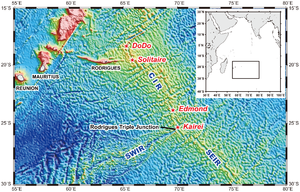Kairei vent field
| Kairei vent field | |
|---|---|
| A series of vents at the Rodrigues triple junction | |
 Map of the Rodrigues triple junction | |
| Location | Indian Ocean |
| Coordinates | 25°19′10″S 70°02′24″E / 25.31944°S 70.04000°E |
| Area | 40–100 square metres (430–1,080 sq ft) |
| Max. elevation | −2,460 metres (−8,070 ft) |
The Kairei vent field is a hydrothermal vent field located in the Indian Ocean at a depth of 2,460 metres (8,070 ft). It is just north of the Rodrigues triple junction, approximately 2,200 kilometres (1,400 mi) east from Madagascar.[1] It is the first hydrothermal field discovered in the Indian Ocean and the first of the series of known vents along the Central Indian Ridge.
History
[edit]The vent field was discovered in 2000 by the R/V Kairei and ROV Kaikō operated by Japan Marine Science and Technology Center (JAMSTEC).[2] In 2001, the site was surveyed with high resolution prior to the deployment of ROV JASON.[3][4]
The vent field was visited again by JAMSTEC in 2009 on the YK09-13 cruise, where the HOV Shinkai6500 was deployed.
Geology
[edit]The field is dominated by sulfide talus, with the approximate area of high-temperature venting constrained to approximately 40 square meters. Fluids from the vent field have been measured in excess of 360 °C (680 °F) and are rich in metals, providing a black-smoker appearance. Elevated chlorinity in venting fluids suggests that phase-separation happens deep below the field.[4]
Biology
[edit]The Kairei vent field is one of the few known locations of the Sea Pangolin, threatened by deep sea mining.[5] It is also a site associated with Gigantopelta aegis and Alviniconcha strummeri gastropods.[6]
It is the site of discovery of Rimicaris kairei, belonging to the family of hydrothermal shrimp found at many sites in the Atlantic Ocean.[7]
Carbon and nitrogen isotopes suggest that there are four distinct trophic levels at the Karei vent field.[3]
Kairei is also of concern with respect to research on deep sea dispersal pathways, with some shared biological communities to those neighboring vent fields (Edmond, Solitaire, DoDo).[8]
References
[edit]- ^ "Kairei Field". vents-data.interridge.org.
- ^ Hashimoto, Jun; Ohta, Suguru; Gamo, Toshitaka; Chiba, Hitoshi; Yamaguchi, Toshiyuki; Tsuchida, Shinji; Okudaira, Takamoto; Watabe, Hajime; Yamanaka, Toshiro; Kitazawa, Mitsuko (July 2001). "First Hydrothermal Vent Communities from the Indian Ocean Discovered". Zoological Science. 18 (5): 717–721. doi:10.2108/zsj.18.717. S2CID 85582014.
- ^ a b Van Dover, C. (October 2002). "Trophic relationships among invertebrates at the Kairei hydrothermal vent field (Central Indian Ridge)". Marine Biology. 141 (4): 761–772. doi:10.1007/s00227-002-0865-y. S2CID 189819863.
- ^ a b Gallant, R. M.; Von Damm, K. L. (June 2006). "Geochemical controls on hydrothermal fluids from the Kairei and Edmond Vent Fields, 23°-25°S, Central Indian Ridge: CONTROLS ON HYDROTHERMAL FLUIDS". Geochemistry, Geophysics, Geosystems. 7 (6): n/a. doi:10.1029/2005GC001067. S2CID 129145462.
- ^ Sigwart, Julia; Conversation, The. "Sea Pangolin: The first ever species endangered by potential deep sea mining". phys.org.
- ^ Fleming, Amy (26 February 2020). "One scientist's mission to save the 'super weird' snails under the sea". The Guardian.
- ^ Watabe, Hajime; Hashimoto, Jun (October 2002). "A New Species of the Genus Rimicaris (Alvinocarididae: Caridea: Decapoda) from the Active Hydrothermal Vent Field, "Kairei Field," on the Central Indian Ridge, the Indian Ocean". Zoological Science. 19 (10): 1167–1174. doi:10.2108/zsj.19.1167. hdl:10069/21977. PMID 12426479. S2CID 11838878.
- ^ Beedessee, Girish; Watanabe, Hiromi; Ogura, Tomomi; Nemoto, Suguru; Yahagi, Takuya; Nakagawa, Satoshi; Nakamura, Kentaro; Takai, Ken; Koonjul, Meera; Marie, Daniel E. P. (16 December 2013). "High Connectivity of Animal Populations in Deep-Sea Hydrothermal Vent Fields in the Central Indian Ridge Relevant to Its Geological Setting". PLOS ONE. 8 (12): e81570. Bibcode:2013PLoSO...881570B. doi:10.1371/journal.pone.0081570. PMC 3864839. PMID 24358117.


 French
French Deutsch
Deutsch